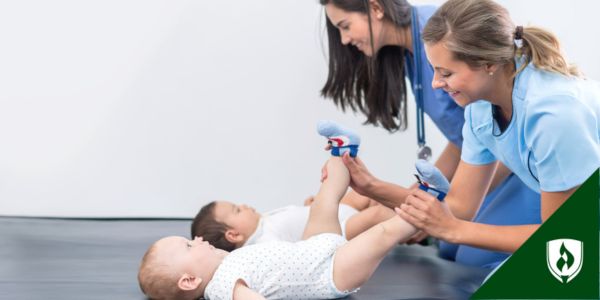Career Change: 8 Reasons Why Being a Physical Therapist Assistant Is Worth the Switch
By Ashley Brooks on 04/13/2020

You groan as your Monday-morning alarm blares in your ear. “I wish I didn’t have to go to work today.” It’s the first thought you have every weekday, and you can’t help but wonder if your job is at least part of the problem.
You can’t help but envy the friends of yours who have stories about their great achievements at work. Even if they’re not working in their childhood dream jobs, they seem to have a general sense of accomplishment and pride in their work—and that matters when you’re considering the long haul of a career. While your current role may be decent enough to slog through, it doesn’t feel like the right fit for you anymore.
You’re not alone in experiencing the nagging feeling that it’s time for a career change. Plenty of people like you have made the tough decision to go back to school to pursue a career that doesn’t make them dread Mondays.
The role of a physical therapist assistant is one of the top careers on your list to explore—but you don’t want to make the same mistake twice. So what makes this position potentially appealing to career changers? We take a closer look at the factors that could make becoming a PTA a perfect next move.
8 Reasons to consider being a physical therapist assistant
Whether your current job feels off because of a bad work environment, boredom or not using your natural skillset, there’s a good chance that being a physical therapist assistant could be the job that sets your career in motion again. Picture yourself enjoying the benefits of this career to see if it’s the right move for you!
1. It's active, hands-on work
Working in an office setting is okay for some people, but you’re sick of staring at a screen for hours on end. In today’s era of technology, a solid career that gets you up and moving can be hard to find. Luckily for you, physical therapist assistant is one job title that fits the bill!
As a physical therapist assistant you’d be frequently on the move and physically active—you’ll help move and set up equipment, guide patients through rehabilitation exercises and physically assist them as they move through rehabilitation facilities.
2. There’s strong projected job growth
No one wants to transition to a career with a poor job outlook, but aspiring physical therapist assistants can feel good about the overall market for these roles. The Bureau of Labor Statistics (BLS) projects employment in this healthcare career to grow by 27 percent from 2018 to 2028—a rate much faster than the national average of 5 percent projected employment growth for all occupations.1
The BLS explains that this strong employment growth projection is due in part to the aging Baby Boomer generation, a population that needs increasing amounts of care as they age. Physical therapist assistants are also in demand as a way to reduce the cost of physical therapy services for patients. As medical technology continues to expand in its ability to save patients through surgery and other treatments, physical therapy rehabilitation will be a growing need to serve those patients and help them return to their daily lives.
3. No two patients are the same
If you’re tired of doing the same, old tasks, day in and day out, every week, becoming a physical therapist assistant could be a nice change of pace.
Not only will you get to learn about your patients’ unique stories, but you’ll assist with different tasks and treatments based on their specific needs. And, if you’re open to traveling, you can work in home healthcare services for a real change of scenery!
4. Your work will help others
A lot of jobs can make you feel disconnected from the world—pushing paper and selling widgets can make you wonder if what you’re doing actually has a purpose. That’s not the case as a physical therapist assistant. There’s no question that every day you spend as a physical therapist assistant is a day spent helping others improve their quality of life.
PTAs work directly with patients to help them recover a full range of motion after surgery, injury or illness. They help patients through stretching, assigning exercises and providing education to patients and their families about their treatment plan. You’ll be able to see the difference you’re making with each patient you serve—and that can be energizing.
5. Seeing client progress is rewarding
Working directly with patients gives physical therapist assistants a front-row seat to the daily challenges and progress they experience as they work through their exercises. Many patients will need a PTAs help in overcoming obstacles, and you’ll be there from day one to give them the support and encouragement they need.
When patients make progress, reach new milestones or even “graduate” from their physical therapy program, you’ll be right there to cheer them on in their hard-won accomplishments. Helping someone regain their mobility and independence can be a profoundly satisfying feeling that makes the hard work you put in every day feel worth it.
6. You get to try your hand at coaching
Many people had youthful dreams of coaching a sports team. Maybe you’ve even helped out as a parent volunteer on your kids’ teams! Becoming a physical therapist assistant is another arena where you can put your coaching skills to use helping others push their limits and achieve their goals.
Many of the skills physical therapist assistants use on the job are similar to those used by coaches. For example, PTAs need to exercise strong judgment and decision making abilities, instruct others how to do something using the learning strategies that work best for them, and use social perceptiveness to understand their patients’ reactions. You learn what makes patients tick and how to push them in a constructive way—a potentially appealing part of the job, even if you don’t get to try your hand at a rousing halftime speech.
7. You can potentially build on past experience
Coaching isn’t the only career that shares some overlap with the work of physical therapist assistant. Many other career experiences lend themselves well to launching a PTA career. These are just a few experiences that could come in handy as you transition to a PTA role:
- Personal training, either yourself or others, gives you useful knowledge of how the body works and serves as a foundation in supporting and encouraging others in working through challenges and physical pain.
- Roles that allow you to inspire and lead others, such as teaching, coaching or tutoring, make a great stepping-stone into the PTA world, where you’ll use similar skills to help patients reach their goals.
- Strong decision-makers, like people who work in the business world or who are in a supervisory position, are well prepared to use their wise judgment in service of their patients.
8. PTA programs can be completed relatively quickly—and transfer credits can help.
Taking the time to embark on a new career can feel scary. The good news is, making the switch to a PTA career doesn’t have to take years of your life.
PTAs are required to have an associate’s degree, according to the BLS, which typically takes around two years to complete. However, the Physical Therapist Assistant program at Rasmussen University can be completed in as few as 18 months.2
Set your new career in motion as a physical therapist assistant
Now that you have more information about being a physical therapist assistant, you’re probably wondering how to make this career change into a reality. Find out with our comprehensive guide, “ Physical Therapist Assistant Education: What to Expect in Your PTA Training.”
Additionally, check out why Physical Therapy Benefits.
Related Articles:
1Bureau of Labor Statistics, U.S. Department of Labor, Occupational Outlook Handbook, [accessed March, 2020] www.bls.gov/ooh/. BLS salary data represents national, averaged earnings for the occupations listed and includes workers at all levels of education and experience. This data does not represent starting salaries. Employment conditions in your area may vary.
2Completion time is dependent upon the number of transfer credits accepted and the number of courses completed each term.




